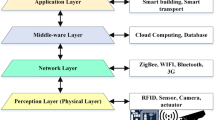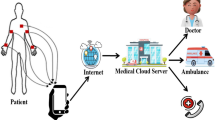Abstract
Passive radio-frequency identification (RFID) tags have long been thought to be too weak to implement public-key cryptography: It is commonly assumed that the power consumption, gate count and computation time of full-strength encryption exceed the capabilities of RFID tags. In this paper, we demonstrate that these assumptions are incorrect. We present two low-resource implementations of a 1,024-bit Rabin encryption variant called WIPR—in embedded software and in hardware. Our experiments with the software implementation show that the main performance bottleneck of the system is not the encryption time but rather the air interface and that the reader’s implementation of the electronic product code Class-1 Generation-2 RFID standard has a crucial effect on the system’s overall performance. Next, using a highly optimized hardware implementation, we investigate the trade-offs between speed, area and power consumption to derive a practical working point for a hardware implementation of WIPR. Our recommended implementation has a data-path area of 4,184 gate equivalents, an encryption time of 180 ms and an average power consumption of 11 \(\upmu \)W, well within the established operating envelope for passive RFID tags.













Similar content being viewed by others
References
Epcglobal inc.: EPC radio-frequency identity protocols class-1 generation-2 UHF RFID protocol for communications at 860 MHz–960 MHz, version 1.0.9. Sept (2005)
Weis, S.A., Sarma, S.E., Rivest, R.L., Engels, D.W.: Security and privacy aspects of low-cost radio frequency identification systems. In: Hutter D., Müller G., Stephan W., Ullmann M., (eds.) SPC, volume 2802 of Lecture Notes in Computer Science, pp. 201–212. Springer (2003)
Dobkin, D.M.: The RF in RFID, 2nd edn. UHF RFID in Practice, Newnes (2012)
Juels, A., Weis, S.A.: Authenticating pervasive devices with human protocols. In: Shoup, V. (ed.) Advances in Cryptology—CRYPTO 2005, Lecture Notes in Computer Science, vol. 3621, pp. 293–308. Springer, Berlin (2005)
Gaubatz, G., Kaps, J-P., Ozturk, E., Sunar, B.: State of the art in ultra-low power public key cryptography for wireless sensor networks. In: Third IEEE International Conference on Pervasive Computing and Communications Workshops, pp. 146–150. (2005)
Feldhofer, M., Dominikus, S., Wolkerstorfer, J.: Strong authentication for RFID systems using the AES algorithm. In: Quisquater J-J., Joye M. (eds.) Cryptographic Hardware and Embedded Systems—CHES 2004: 6th International Workshop, LNCS, vol. 3156, pp. 357–370 Springer (2004)
Nohl, K., Plötz, H.: MIFARE—little security, despite obscurity. Technical report, 24th Chaos Communication Congress (2007)
Oren, Y., Feldhofer, M.: WIPR—public-key identification on two grains of sand. In: Dominikus S., (ed.) Workshop on RFID Security, pp. 15–27 (2008)
Rabin, M.O.: Digitalized signatures and public-key functions as intractable as factorization. (1979)
Goldwasser, S., Micali, S.: Probabilistic encryption. J. Comput. Syst. Sci. 28(2), 270–299 (1984)
Naccache, D.: Method, sender apparatus and receiver apparatus for modulo operation. US Patent 5,479,511, 26 Dec (1995)
Shamir, A.: Memory efficient variants of public-key schemes for smart card applications. In: Advances in Cryptology-EUROCRYPT’94, pp. 445–449. Springer (1995)
Shamir, A.: SQUASH-a new MAC with provable security properties for highly constrained devices such as RFID tags. In: Fast Software Encryption, pp. 144–157. Springer (2008)
Finiasz, M., Vaudenay, S.: When stream cipher analysis meets public-key cryptography. In: Selected Areas in Cryptography, pp. 266–284. Springer (2007)
Furbass, F., Wolkerstorfer, J.: ECC processor with low die size for RFID applications. In: IEEE International Symposium on Circuits and Systems, 2007. ISCAS 2007. pp. 1835–1838. IEEE (2007)
Blass, E.-O., Kurmus, A., Molva, R., Noubir, G., Shikfa, A.: The \(f_f\)-family of protocols for RFID-privacy and authentication. IEEE Trans. Dependable Secur. Comput. 8(3), 466–480 (2011)
Chien, H.-Y.: SASI: a new ultralightweight RFID authentication protocol providing strong authentication and strong integrity. IEEE Trans. Dependable Secur. Comput. 4(4), 337–340 (2007)
Oren, Y., Feldhofer, M.: A low-resource public-key identification scheme for RFID tags and sensor nodes. In: Basin, D.A., Capkun, S., Lee, W. (eds.) WISEC, pp. 59–68. ACM, New York (2009)
Wu, J., Stinson, D.R.: How to improve security and reduce hardware demands of the WIPR RFID protocol. In: IEEE International Conference on RFID, 2009. pp. 192–199. IEEE (2009)
Arbit, A., Oren, Y., Wool, A.: A secure supply-chain RFID system that respects your privacy. Pervasive Computing, IEEE, Accepted for publication
Najera, P., Roman, R., Lopez, J.: User-centric secure integration of personal RFID tags and sensor networks. Secur. Commun. Netw. 6(10), 1177–1197 (2013)
Plos, T., Michael, H., Feldhofer, M., Stiglic, M., Cavaliere, F.: Security-enabled near-field communication tag with flexible architecture supporting asymmetric cryptography. IEEE Trans. VLSI Syst. 21(11), 1965–1974 (2013)
Wenger, E., Unterluggauer, T., Werner, M.: 8/16/32 shades of elliptic curve cryptography on embedded processors. In: Paul G., Vaudenay S., (eds.) INDOCRYPT, volume 8250 of Lecture Notes in Computer Science, pp. 244–261. Springer (2013)
Batina, L., Seys, S., Singelée, D., Verbauwhede, I.: Hierarchical ECC-based RFID authentication protocol. In: Juels A., Paar, C. (eds.) RFIDSec, volume 7055 of Lecture Notes in Computer Science, pp. 183–201. Springer (2011)
Aigner, M., Plos, T., Ruhanen, A., Coluccini, S.: Secure semi-passive RFID tags—prototype and analysis. Technical report, BRIDGE Project (2008)
Menezes, A.J., Van Oorschot, P.C., Vanstone, S.A.: Handbook of applied cryptography. CRC, Boca Raton (1996)
Luby, M., Rackoff, C.: How to construct pseudorandom permutations from pseudorandom functions. SIAM J. Comput. 17(2), 373–386 (1988)
Barthel, H.: UHF RFID regulations. http://www.oecd.org/sti/interneteconomy/35472969.pdf (2006)
Finkenzeller, K.: RFID Handbook : Fundamentals and Applications in Contactless Smart Cards and Identification. Wiley, New York (2003)
Cadence incisive tool suite. http://www.cadence.com/products/pages/default.aspx
TSMC65LP 65nm low-power process silicon process. http://www.tsmc.com/english/dedicatedFoundry/technology/65nm.htm
Virage logic standard cell libraries. http://www.synopsys.com/dw/ipdir.php?ds=dwc_standard_cell
Lenstra, A.K., Verheul, E.R.: Selecting cryptographic key sizes. J. Cryptol. 14(4), 255–293 (2001)
Johnston, A.M.: Digitally watermarking rsa moduli. Cryptology ePrint Archive, Report 2001/013. http://eprint.iacr.org/2001/013 (2001)
Advanced microcontroller bus interface open specifica- tion. http://www.arm.com/products/system-ip/amba/amba-open-specifications.php
Finkenzeller, K.: RFID Handbook: Fundamentals and Applications in Contactless Smart Cards, Radio Frequency Identification and Near-field Communication. Wiley, New York (2010)
Arbit, A., Oren, Y., Wool, A.: Toward practical public key anti-counterfeiting for low-cost EPC tags. In: 2011 International IEEE Conference on RFID, vol. 4, pp. 184–191 Orlando, USA (2011)
Acknowledgments
We thank the anonymous reviewers for their helpful and instructive comments.
Author information
Authors and Affiliations
Corresponding author
Rights and permissions
About this article
Cite this article
Arbit, A., Livne, Y., Oren, Y. et al. Implementing public-key cryptography on passive RFID tags is practical. Int. J. Inf. Secur. 14, 85–99 (2015). https://doi.org/10.1007/s10207-014-0236-y
Published:
Issue Date:
DOI: https://doi.org/10.1007/s10207-014-0236-y




